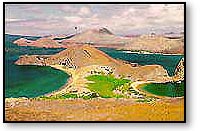The Galapagos Islands
Geographia iExplore
Ecuador |
 The
archipelago is a little world within itself, or rather a satellite
attached to America, whence it has derived a few stray colonists,
and has received the general character of its indigenous productions.
Considering the small size of these islands, we feel the more astonished
at the number of their aboriginal beings, and at their confined
range. Seeing every height crowned with its crater, and the boundaries
of most of the lava-streams still distinct, we are led to believe
that within a period, geologically recent, the unbroken ocean was
here spread out. Hence, in both space and time, we seem to be brought
somewhat nearer to that great fact--that mystery of mysteries--the
first appearance of new beings on this earth
The
archipelago is a little world within itself, or rather a satellite
attached to America, whence it has derived a few stray colonists,
and has received the general character of its indigenous productions.
Considering the small size of these islands, we feel the more astonished
at the number of their aboriginal beings, and at their confined
range. Seeing every height crowned with its crater, and the boundaries
of most of the lava-streams still distinct, we are led to believe
that within a period, geologically recent, the unbroken ocean was
here spread out. Hence, in both space and time, we seem to be brought
somewhat nearer to that great fact--that mystery of mysteries--the
first appearance of new beings on this earth
.---Charles
Darwin, Voyage of the Beagle
Location, Geography , Climate
Ecuador's most beloved and popular national park lies in splendid isolation about 960 kilometers off the mainland. Made famous by Charles Darwin, the Galapagos Islands are no less enthralling now than they were a hundred years ago. Every year, thousands of curious visitors journey to the remote islands to behold the wondrously variegated wildlife that inspired The Origin of Species.
 Relatively young, the Galapagos sprouted out of the
Pacific from a suboceanic lava vent on the ocean floor. This same process
created the Hawaiian Islands, and it continues today in both island
groups. In the Galapagos, the vent is gradually creeping east with
the Nazca plate, forming more islands as it moves. There are currently
sixty named islands, the principals being Fernandina, Isabela, Baltra,
James, Santa Cruz and San Cristobal.
Relatively young, the Galapagos sprouted out of the
Pacific from a suboceanic lava vent on the ocean floor. This same process
created the Hawaiian Islands, and it continues today in both island
groups. In the Galapagos, the vent is gradually creeping east with
the Nazca plate, forming more islands as it moves. There are currently
sixty named islands, the principals being Fernandina, Isabela, Baltra,
James, Santa Cruz and San Cristobal.
The climate in the islands is generally mild and comfortable. From June to December, the Humbolt current rises up from Antarctica, its cooler air bringing in the rainy season. In January, the Humbolt's withdrawal allows the warmer equatorial current to move in, bringing with it a dry season that endures through May.
History
In the fall of 1835, the Galapagos Islands' most famous visitor, Charles Darwin, arrived on the H.M.S. Beagle and began collecting and observing the archipelago's unique animal and plant life. At the time, Darwin did not fully appreciate what he was seeing. Only after he returned home to England did the scientist begin to formulate his theory of evolution. Though the name Darwin is inseparable from the islands' history, they were actually discovered in 1535 by a Spanish bishop named Fray Tomas de Berlanga, who named the island Galapagos after the impressive giant tortoises.
Much of the same flora and fauna that inspired Darwin's The Origin of Species still thrives on the Galapagos today. Appropriately, ninety-seven percent of the island is national park. The legendary marine and land iguanas, the giant tortoises, and seal colonies of the Galapagos are among nature's most fantastic beings. Visitors will gasp at these stunning animals, all of which are highly approachable as their isolated evolution has not conditioned them to fear humans. Iguanas and tortoises bask in the sun like bored movie stars, feet away from the photo-snapping Homo Sapiens. Though their indifference may make the animals seem humorously aloof, their very ignorance makes them vulnerable. A few bad experiences with humans can alter their behavior irrevocably and turn them reclusive. Respect their natural hospitality and keep your hands to yourself.
The Galapagos also offer some of the world's best scuba diving. Dive boats that tour the islands can be reserved on the mainland. Devil's Crown, an atoll near Floreana Island, is a submarine wonderland that shouldn't be missed. The shallows of this sunken volcano are burgeoning with an incredible myriad of corals and fish. Giant tortoises hover over the reef like living balloons, and sharks can sometimes be found, harmless and asleep on the sandy bottom.
The flight from Guayaquil takes about an hour and a half, and visitors can land on either Baltra or San Cristobal. Upon reaching the Galapagos, the only way to tour the islands is to do it the way Darwin did, by boat. Due to the biologically sensitive nature of the islands, trips ashore must be taken in the presence of a licensed guide. They come with the boat.
